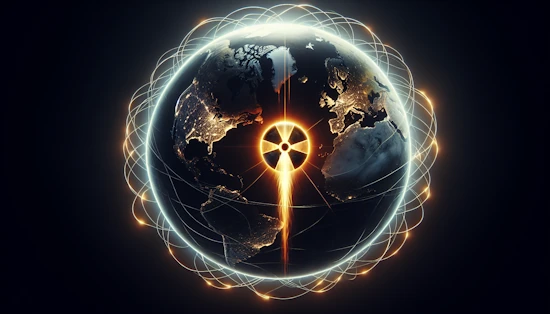The increasing geopolitical tensions and advancements in technology have rekindled concerns around nuclear warfare, highlighting the urgent need for effective nuclear non-proliferation measures. With over 13,000 nuclear weapons distributed among nine countries, the specter of atomic weapons, including nuclear bombs, hydrogen bombs, and intercontinental ballistic missiles, represents an unprecedented threat to global security. The potential for nuclear attacks, propelled by ballistic missiles and nuclear missiles, stands as a stark reminder of the catastrophic aftermath these weapons of mass destruction could unleash, affecting not just the immediate zones but also posing long-term environmental and health challenges worldwide.

Addressing the nuclear warfare threat necessitates a multifaceted approach that encompasses not just arms control but also diplomacy and global cooperation to prevent nuclear proliferation. Strategies to mitigate the risks associated with nuclear arsenals, including efforts toward disarmament and strengthening international treaties like the New START Treaty, are critical in the face of increasing nuclear threats. As the article unfolds, it will delve deeper into the historical context, examining the role of major international actors and the current landscape of nuclear warfare, including the nuances of nuclear warfare today and the persistent challenges that loom in regions like Russia, highlighting the importance of concerted efforts to stem the tide of nuclear escalation.
Historical Context and Recent Developments
The historical backdrop of nuclear warfare and recent geopolitical maneuvers paints a complex picture of escalating tensions and strategic deployments. This section explores key developments, particularly focusing on Russia’s military activities and the broader implications for global security.
Russia’s Strategic Military Posture in Belarus
In response to perceived threats and in a strategic move, Russia has increased its military presence in Belarus, significantly impacting the security landscape of Eastern Europe. By the end of 2022, Russia had not only deployed Iskander missiles, which are capable of carrying nuclear warheads but also began training Belarusian pilots to operate aircraft that could deploy these weapons. The establishment of specific storage facilities and railway systems in Belarus suggests preparations for potentially housing a more extensive nuclear arsenal.
Tactical Nuclear Weapons and International Responses
The shift of tactical nuclear weapons into Belarus, closer to NATO territories, is a critical element of Russia’s military strategy. This move, one of the westernmost deployments of Russia’s atomic arsenal, serves as a clear signal to NATO and Western nations, reflecting heightened military readiness. Despite some experts downplaying the military significance, the political implications are profound, influencing international military and diplomatic strategies.
Escalation and Global Stability
The transfer of nuclear capabilities to Belarus culminates in a series of military drills involving tactical nuclear weapons, underscoring the Kremlin’s readiness to demonstrate its military prowess. These developments occur amidst ongoing tensions and war in Ukraine, with Western nations, particularly the United States and NATO allies, expressing serious concerns over Russia’s nuclear modernization programs and the suspension of the New START treaty by the Kremlin.
The Role of International Treaties and Advocacy
The historical narrative of nuclear arms control highlights significant milestones, such as the Manhattan Project, the Non-Proliferation Treaty, and the Comprehensive Test Ban Treaty, aimed at curbing the spread and testing of nuclear weapons. However, recent actions by nuclear states, notably Russia and North Korea, challenge the effectiveness of these treaties. The international community continues to advocate for stringent measures to prevent nuclear proliferation, emphasizing the need for a renewed commitment to global nuclear disarmament.
These historical and recent developments emphasize the delicate balance between national security interests and global stability, highlighting the urgent need for strategic diplomacy and international cooperation to mitigate the risks of nuclear escalation.
The Role of NATO and Western Responses
NATO’s strategic response to the evolving landscape of nuclear threats has been robust and multifaceted, emphasizing deterrence, defense, and dialogue. The alliance’s approach hinges on a combination of military readiness, diplomatic efforts, and support for arms control initiatives, all aimed at maintaining global stability and preventing nuclear escalation.
NATO’s Comprehensive Deterrence Strategy
NATO’s deterrence policy is meticulously crafted to preserve peace and prevent coercion. The alliance remains a nuclear entity, underpinned by the strategic nuclear capabilities of the United States, the United Kingdom, and France. These powers collectively provide a security umbrella over the alliance, significantly contributing to the deterrence of nuclear and conventional threats.
- Strategic Military Exercises: NATO’s operational readiness is showcased through large-scale exercises like Steadfast Defender 2024, which involves extensive participation from member states, demonstrating the alliance’s capability to mobilize rapidly in response to threats.
- Nuclear Planning Group: This forum is crucial for member nations to consult on matters related to nuclear deterrence, ensuring a unified and informed approach towards nuclear defense strategies.
- Dual-Capable Aircraft (DCA): Several NATO countries contribute to this capability, providing aircraft that can be equipped with nuclear weapons, enhancing the flexibility and credibility of NATO’s nuclear deterrence.
Defense and Diplomacy: Balancing the Scale
NATO’s strategy extends beyond military measures, incorporating diplomatic and economic actions to address and mitigate nuclear threats. The alliance’s dual approach of deterrence and dialogue aims to reduce the likelihood of conflict, making any potential aggression too costly to undertake.
- Diplomatic Engagements and Sanctions: In response to Russia’s actions in Ukraine, NATO has implemented unprecedented diplomatic and economic sanctions aimed at depleting the resources available to the Kremlin’s war efforts.
- Support for Arms Control: NATO actively supports various disarmament treaties and initiatives, such as the New START and the INF Treaty, which play crucial roles in reducing the global reliance on nuclear weapons.
Supporting Ukraine: A Testament to NATO’s Commitment
Although Ukraine is not a member, it remains a significant partner to NATO. The alliance’s support for Ukraine in the face of Russian aggression is a clear indicator of NATO’s commitment to regional stability and its deterrence strategy.
- Military and Humanitarian Aid: NATO and its member countries have provided substantial aid to Ukraine, including military equipment and humanitarian assistance, totaling billions of dollars.
- Training and Preparedness: Allied forces are actively involved in training Ukrainian troops, ensuring they are well-prepared to use the equipment provided effectively.
Enhancing Global Security Posture
NATO’s response to nuclear threats is not limited to immediate measures but also involves long-term strategies to enhance global security infrastructure and preparedness against a range of threats.
- Intelligence Sharing and Surveillance: The alliance has intensified efforts in intelligence sharing, crucial for early threat detection and coordinated response.
- Infrastructure Protection: Strengthening the security of critical infrastructure, particularly undersea and energy infrastructures, is a priority to prevent sabotage and ensure energy security.
Through these comprehensive measures, NATO continues to play a pivotal role in maintaining international peace and security, adapting its strategies to meet the challenges of modern warfare and nuclear threats. The alliance’s actions are carefully calibrated to deter aggression without escalating conflicts, underscoring its foundational principle of collective defense.
Russian Nuclear Signaling and Military Movements
The intensification of Russian nuclear signaling amid the conflict in Ukraine has underscored a strategic pivot towards a more aggressive stance on nuclear deterrence. Russian officials have leveraged their nuclear capabilities as a form of strategic communication, aimed at deterring NATO states from direct involvement and influencing the geopolitical landscape.
Coercive Nuclear Strategy
Russia has not shied away from a strategy that intertwines nuclear threats with conventional military operations. This approach, often referred to as coercive nuclear escalation, integrates tactical nuclear weapons into Russia’s broader military strategy. By intertwining these threats with conventional tactics, Russia aims to amplify the deterrent effect while maintaining a posture that keeps the international community at bay.
Tactical Nuclear Drills and Western Reactions
In a direct response to statements from Western leaders hinting at increased involvement in Ukraine, Russia has planned tactical nuclear weapons drills. These drills serve as both a preparation and a stark warning—highlighting Russia’s readiness to escalate to nuclear means if perceived Western provocations continue. This move follows comments from French and British officials that suggested a potential escalation in their military support for Ukraine, which Russia views as a direct threat to its sovereignty and a catalyst for nuclear escalation.
Stockpile and Readiness
As of mid-2023, Russia’s active nuclear arsenal included approximately 4,489 warheads. This significant stockpile is not just a numerical figure but a central element of Russia’s global defense strategy. Russian military doctrine emphasizes the role of nuclear forces as a cornerstone of national security, particularly in deterring potential aggressors and maintaining a balance of power within the international system.
Signaling During Key Military Phases
Throughout various stages of the conflict in Ukraine, Russian officials have strategically adjusted their nuclear rhetoric. This calibrated signaling is often intensified during key military operations or in response to international developments that Russia perceives as adverse. The underlying message is clear: Russia considers its nuclear capabilities as the ultimate guarantor of national security, especially when conventional military strategies face challenges.
Potential Scenarios for Nuclear Use
The discourse within Russian military and political circles suggests that the threshold for nuclear weapon use could be lower than previously anticipated, especially if Russia faces the risk of a significant military defeat in Ukraine. Such a scenario would not only threaten the stability of the region but could also redefine the norms of nuclear engagement globally, setting a precedent for nuclear response to conventional military failures.
Through these actions and strategies, Russia continues to shape the global narrative around nuclear warfare, using its arsenal as both a shield and a spear in its geopolitical endeavors. The implications of this approach are profound, extending beyond the immediate zones of conflict and influencing global nuclear policy and security strategies.
Global Reaction to Nuclear Escalation Threats
The global community has been deeply concerned by the resurgence of nuclear threats, particularly from North Korea’s frequent missile tests and the strategic military postures of major nuclear powers. The responses from various countries and international bodies illustrate a complex tapestry of diplomacy, military readiness, and economic sanctions aimed at mitigating these threats.
North Korea’s Persistent Missile Tests and International Sanctions
North Korea’s continued missile tests have not only destabilized the region but have also prompted a robust response from the international community. The United Nations Security Council, reflecting global consensus, has imposed stringent sanctions on North Korea. These sanctions aim to curb its nuclear and ballistic missile programs by restricting access to international banking channels and limiting imports of oil and other crucial materials.
Diplomatic Efforts and Regional Security Measures
The role of major powers, particularly China and Russia, has been pivotal due to their historical influence over North Korea. Diplomatic dialogues have been intensified, with these nations playing a crucial role in trying to bring North Korea to the negotiation table. Concurrently, the United States has fortified its regional security posture by deploying advanced missile defense systems in South Korea and Japan. These systems are designed to intercept ballistic missiles, serving as a deterrent against potential attacks.
Joint Military Exercises and Their Implications
In a show of solidarity and preparedness, the United States and South Korea have conducted joint military exercises, which, while defensive in nature, have been perceived by North Korea as provocative. These exercises demonstrate the readiness of allied forces but also escalate tensions, leading to a cyclical pattern of military maneuvers and missile tests by North Korea.
European Union’s Stance and Sanctions
The European Union has also played a significant role by imposing its own set of sanctions on North Korea. These sanctions are part of a broader strategy to pressure North Korea into compliance with international disarmament obligations. The EU’s actions underscore a unified international effort to address nuclear threats through economic and diplomatic channels.
The Growing Concern Over Regional Nuclear Proliferation
The escalation of nuclear rhetoric and capabilities in the region has raised alarms about the potential for further nuclear proliferation. Countries like South Korea and Japan have begun to reconsider their own nuclear strategies, which could lead to a domino effect of nuclear armament if not carefully managed through diplomatic channels.
The Broader Implications of Global Nuclear Threats
The increasing nuclear capabilities of countries like China, Russia, and Iran, coupled with their involvement in regional conflicts, pose a significant challenge to global stability. The United States and Ukraine have been preparing for potential nuclear scenarios by enhancing their readiness through the distribution of radiation detection equipment and the development of new nuclear contingency plans, known as the “playbook” for nuclear response.
Strategic Deterrence and the Balance of Terror
The concept of deterrence remains central to the nuclear policies of major powers. The possession of nuclear weapons by states is framed not as a means to wage nuclear war but as a deterrent to prevent such a conflict. This delicate balance of terror necessitates continuous dialogue and strategic arms control to prevent the unthinkable consequences of nuclear warfare.
Through these multifaceted responses, the global community continues to navigate the precarious landscape of nuclear threats. The collective efforts aim not only to deter potential aggressors but also to foster a climate of dialogue and disarmament, which is crucial for long-term global stability and security.
Conclusion
The discourse on global nuclear threats and strategic deterrence mechanisms underscores the precarious balance between national security priorities and the imperative for international cooperation in nuclear disarmament. Throughout this article, the historical context, strategic movements, and global reactions to the specter of nuclear warfare have been meticulously examined, highlighting the complex interplay of diplomatic, military, and technological factors that shape the global nuclear landscape. By revisiting the key developments and strategic postures of states like Russia and responses from entities such as NATO and the international community, the article has emphasized the critical need for a multi-pronged approach to nuclear de-escalation and disarmament to safeguard global stability.
The implications of the findings discussed are profound, extending beyond academic discourse to inform policy-making and international relations. The role of diplomacy, bolstered by robust international treaties and heightened global cooperation, emerges as indispensable in the face of escalating nuclear threats. The potential for further research or action is evident, highlighting the urgent need for renewed commitment to dialogue, transparency, and collective action in addressing the challenges posed by nuclear armament. As the global community stands at a crossroads, the path towards a more secure and nuclear-free world mandates unwavering commitment to peace, security, and sustainable development.







